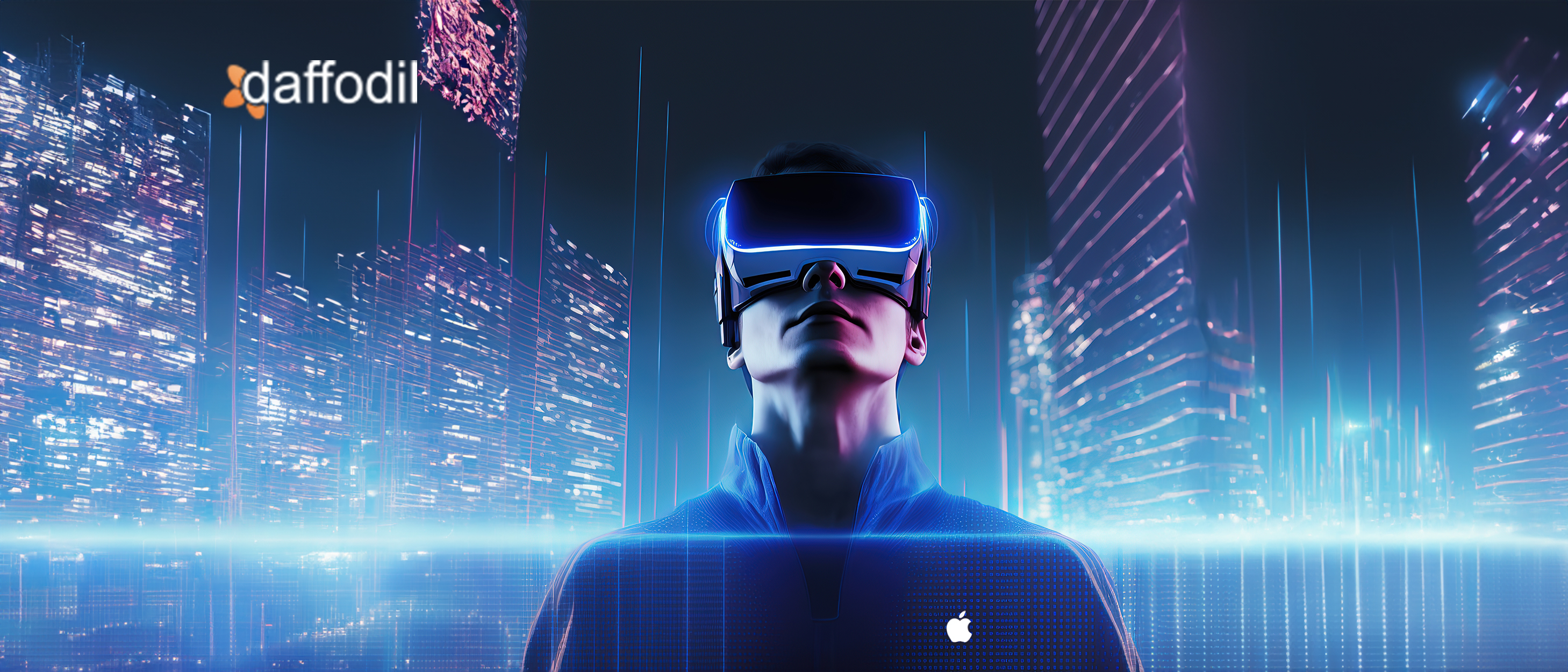
The extent of innovation and advancement in Augmented Reality (AR) and Virtual Reality (VR) wearable technology has been explosive in the last five years alone. The latest entrant in this domain of technological disruption comes in the form of the Apple Vision Pro; a spatial computer vision-enabled headset that is far more than what meets the eye.
Apple announced during its Worldwide Developers Conference (WWDC) held on June 5, 2023, that it will soon be releasing the Vision Pro, a spatial computer vision device that maps digital technology onto your immediate physical space. The device is said to seamlessly blend AR and VR with the physical world for a never-before-seen highly interactive user experience. If the promotional campaigns that Apple unveiled are anything to go by, the Vision Pro may prove to be a significant milestone in wearable technology.
Additionally, the computer vision framework is also expected to be a boon for software developers. Developers will be equipped with a powerful set of tools and capabilities that quite literally will give them hands-on control over code walkthroughs, enhancements, and debugging.
As per the market statistics aggregator MarketSplash, AR-VR is one of the fastest developing technologies in terms of global market share, from being worth $3.6 billion in 2016 to $22.9 billion in 2020, with over 14 million devices sold in 2019 alone. The International Data Corporation projects a massive five-year CAGR for the aggregate product value of these devices, as shown below.

Source: IDC
In this article, we will explore the potential for Apple Vision Pro to revolutionize wearable tech. We will particularly delve deep into the plethora of benefits that it will unlock for software developers and system design experts to develop state-of-art system architectures and programs.
What is the Apple Vision Pro and How Does it Work?
Apple Vision Pro is a wearable headset that will introduce technology termed by the tech giant as "extended reality" or XR that takes users beyond the confines of their screens by leveraging AR-adjacent capabilities. It presents all the iOS apps that regular Apple customers have come to love across an immersive canvas.
Users will be able to make notes, FaceTime, organize documents, design graphics, and text their contacts through the power of visionOS, Apple's latest operating system. VisionOS is an all-new framework that brings a comprehensive toolchain for the development of panoramic spatial experiences in augmented or extended reality.
An astounding number of cutting-edge hardware and software components go into the experiences provided by the device. Several cameras and sensors are embedded across the aluminum alloy frame, with a Light Seal keeping stray light beams away from the user's view. Advanced machine learning algorithms help present realistic images and read your gestures and expressions, training the system in real-time. Innovative dual-chip design, raytracing, and a micro-OLED display system are some other patented advancements driving the incredible user experience.
Here are some of the groundbreaking elements that the Apple Vision Pro is said to bring to its wearers:
- While spatial activities such as viewing a movie, writing a note, or FaceTiming occur within Vision Pro, the user would feel like these interactions are happening physically in front of them.
- You would experience the sounds in 3D with life-size imagery calibrated to the Spatial Audio system to give you the feel of depth or distance in the panoramas that appear to surround you.
- Activities that you would generally carry out on your smartphone, iPad, or television would be presented to you with a never-before-seen level of immersion.
- The Vision Pro will be synced with your iPhone, iPad, or Mac blending visionOS with the existing functionalities of iOS, keeping your data synced with iCloud as well.
- Entertainment in the form of gaming, watching a movie, browsing the internet, and so on can be experienced at a grand and mesmerizing scale.
- Collaborating with co-workers on a project becomes frictionless with communication feeling more natural, with limitless control over how immersive you want the experience to be.
What will Apple Vision Pro Bring to App Development?
Apple Vision Pro, the new spatial computing platform has the potential to revolutionize the way software developers, cybersecurity experts, software testers, and UI/UX developers create and interact with applications.
For App Developers:
Vision Pro offers a new way to develop immersive and interactive experiences for users. Taking advantage of Vision Pro's spatial capabilities could lead to the development of new and innovative apps for users to interact with their favorite apps, such as gaming, education, and productivity. Other advanced technical capabilities include:
- Computer Vision-Driven Applications: Developers will be able to leverage advanced computer vision algorithms to build applications that recognize faces and objects and potentially even detect emotions. These capabilities could help develop applications for diverse fields such as psychiatric therapy, security, and forensic psychology.
- Seamless Build and Deploy: The development process can be further simplified through a unified API that can integrate with other Apple frameworks such as Core ML and ARKit. Developers will then be able to quickly build and deploy computer vision features in applications.
- Image Segmentation: Developers can get into the granular aspects of image segmentation by being able to segment images into various layers and regions and interact with them spatially. They can analyze and manipulate specific parts of an image for diverse implementations in areas like editing, and image-based machine learning.
For Cybersecurity Professionals:
Vision Pro presents new challenges and opportunities. On the one hand, Vision Pro's immersive nature could make it easier for attackers to trick users into giving up their personal information or installing malware. On the other hand, Vision Pro's unique capabilities could also be used to create new security features that make it harder for attackers to succeed. The patented Optic ID authentication system can be experimented with to expand the possibilities for increased security and access control.
For Software Testers:
Vision Pro offers a new way to test the usability and functionality of applications. By using Vision Pro's spatial capabilities, testers can simulate real-world use cases and identify potential problems before they impact users. This could lead to more reliable and user-friendly apps. More collaborative testing efforts using this technology can help gain a more holistic understanding of bugs for highly insightful reporting and test analytics.
For UI/UX Designers:
Vision Pro offers a new way to create visually appealing and user-friendly interfaces. By taking advantage of Vision Pro's spatial capabilities, designers can create interfaces that feel natural and intuitive to use. This could lead to a better user experience for all types of applications.
ALSO READ: 7 Real Time Applications of Augmented Reality in Mobile Apps
Will the Vision Pro live up to the hype?
Given how Apple's current competitors in the wearable VR market have performed thus far, some people think the Vision Pro may well be the iPhone of mixed-reality headsets, while others remain skeptical. Let's see how the two most significant competitors of Vision Pro have performed:
- The current market leader, Meta, has sold almost 20 million Quest headsets as of March. According to the Wall Street Journal, less than half of Quests were still in use six months after purchase, despite being far less expensive and having a head start on the competition.
- Only around 300,000 Microsoft HoloLens headsets have been sold since its 2016 launch; the updated variant costing the same $3,500 as the Vision Pro.
Why might Vision Pro put up significant numbers in comparison? The short answer is that the cool quotient, distinctive design, and fandom associated with Apple devices sets them apart. They have had a successful track record of shaking up established markets with disruptive products. However, buyers won't know if they actually want to give the Vision Pro a go until it hits the market early next year.
Apple Vision Pro is a Milestone in AR-VR Wearable Tech
The spatial computer vision technology of the Apple Vision Pro enables users and developers alike to leverage its spatial interface to unlock new opportunities for entertainment, collaboration, as well as innovation. The product is expected to hit the consumer markets next year and the possibilities for it becoming a black swan event for the ages are tremendous. Watch this space for more updates and if you are looking to leverage Daffodil's AR/VR expertise to elevate the capabilities of your digital solutions you can book a free consultation with us today.




